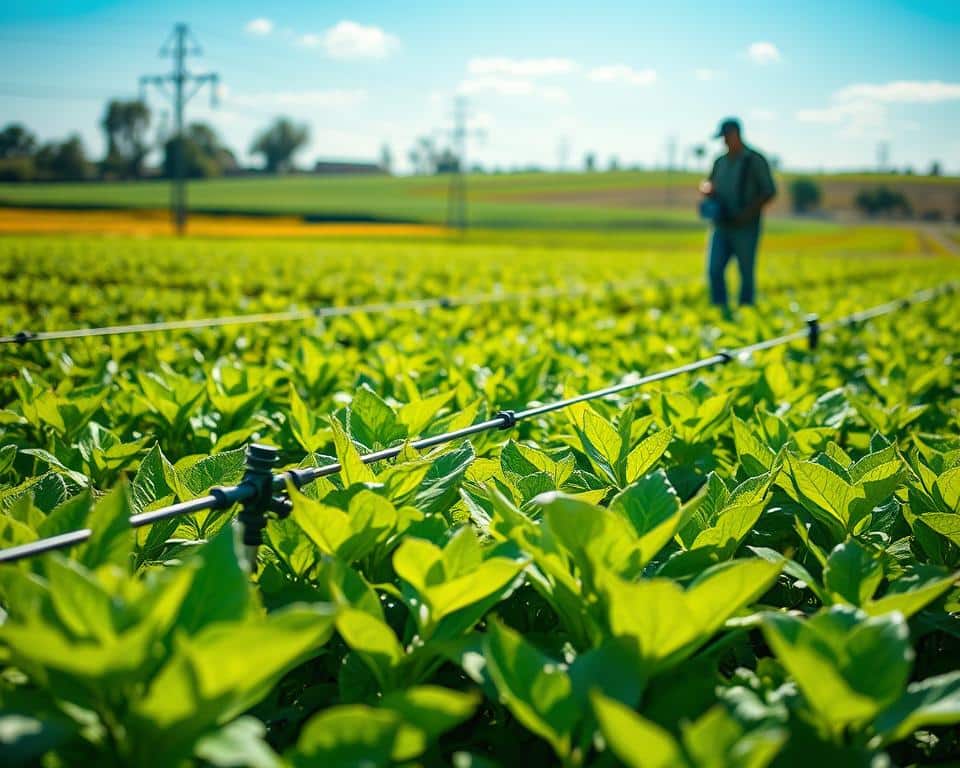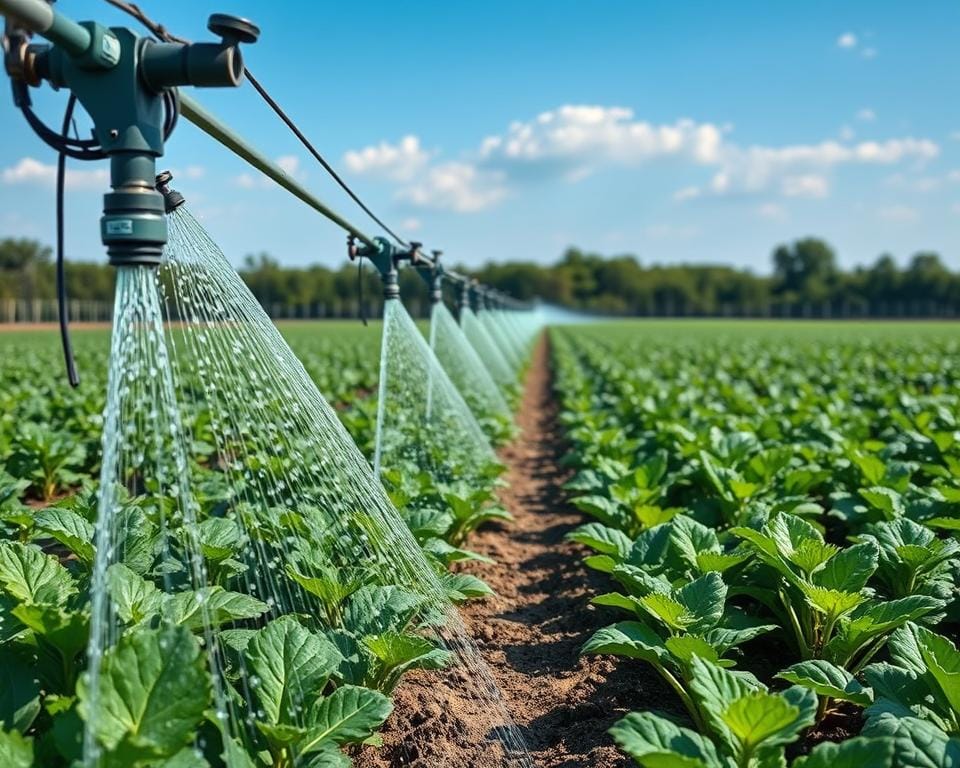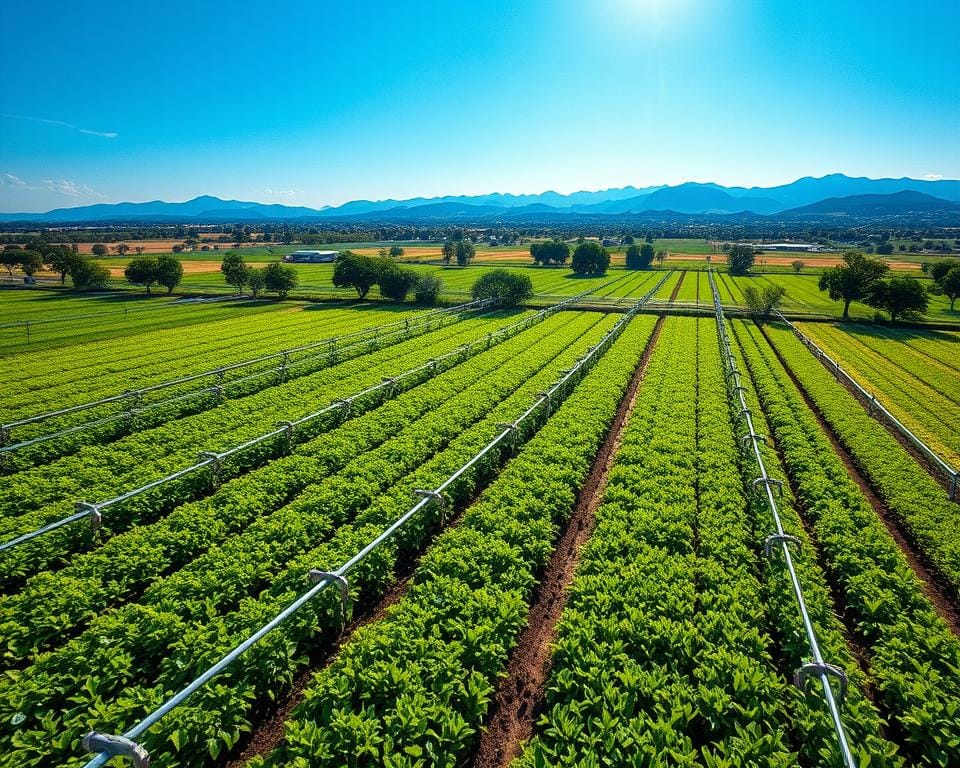Around the world, farming uses about 70% of all fresh water each year. This is just to water 25% of the land we can farm on. With climate change, we’re seeing more droughts and floods. This makes it important to use water wisely. Efficient water resource management has never been more crucial. Moving to precision agriculture can make farming use water much better. It does this by using new tech.
Precision agriculture is a part of smart farming. It uses cutting-edge tech to give crops exactly what they need for water and nutrients. This approach makes better use of water (WUE) and saves a lot of it. With tools like live data and smart watering systems, precision farming meets the growing need for water without wasting it.
Take smart watering systems as an example. Research shows they really help spread water around more effectively. Technologies like forecasts, remote sensors, and Internet of Things (IoT) gadgets are key. They watch the crops’ needs and adjust. In Australia’s Murray Darling Basin, a project called COALA made watering 20% more efficient with these tech.
The Importance of Water Conservation in Agriculture
Agriculture uses a lot of our global freshwater, making wise water use essential for sustainability. The challenge of water scarcity grows with climate change and more people. To tackle this, effective water management in farming is key.
One effective method is drip irrigation, which saves water in farming. By scheduling when to water crops, we avoid wasting water. Using compost improves soil, holding more water and boosting nutrients for better water use.
Cover crops help save water by reducing runoff and helping soil retain more moisture. Conservation tillage enhances soil health and water storage. Crop rotation keeps the soil moist and stops pests and diseases.

Technological advances like precision agriculture improve water management. With IoT sensors, smart irrigation systems can track water needs in real time. These sensors ensure irrigation happens just right, avoiding waste and saving water.
Using sustainable methods and technology, we can aim for a future of efficient water use. Embracing these innovations, agriculture can not only succeed but also safeguard our water resources for coming generations.
Traditional vs. Modern Irrigation Methods
The way we water our crops has changed to help feed more people and save resources. With the world needing a lot more food in the next 30 years, using better ways to irrigate is key. We must switch to more effective irrigation to keep our food supply stable.
Traditional Irrigation Practices
For hundreds of years, farmers have used simple methods like gravity irrigation. This method spreads water evenly, but it’s not always what the crops need. It can waste water and not work well everywhere.
Even though it’s easy to use, gravity irrigation may not do well with hilly land or if water spreads unevenly. These issues can lower how much water actually helps the crops.
Modern Irrigation Techniques
But now, farming uses new ways to water crops, like high-tech systems that save water. These modern systems are great for dealing with less rain, growing cities, and keeping water use smart. Pressure-driven systems water plants just right, helping farms produce more.
Using precision irrigation can cut water use in half when compared to old methods. This makes it a smart choice for the future of farming.
| Aspect | Traditional Irrigation | Modern Irrigation |
|---|---|---|
| Method | Gravity irrigation | Pressure-driven systems |
| Water Distribution Efficiency | Variable | Highly controlled |
| Field Variability | Often ignored | Precisely managed |
| Crop Water Needs | Uniform application | Customized application |
| Water Usage | Higher | Reduced by up to 50% |
Modern irrigation methods are a game changer. They make sure different crops get just what they need, saving a lot of water. As we keep making these smart changes, it’s vital we keep creating new ways to use water wisely in farming. This will help us have enough food for everyone in the future.
Precision Agriculture and Water Conservation Technologies
Precision agriculture combines new technology with farming to manage resources better. This approach uses AI and real-time data, helping farmers track and react to changing conditions. This makes farming more efficient and productive.
Smart Irrigation Systems
Smart irrigation systems are key in using water wisely. They use soil moisture data and crop models to water crops just right. This saves water and makes sure crops get what they need when they need it.

IoT Devices and Sensors
IoT devices change the way farmers care for crops. They monitor soil, weather, and crop health in real-time. This data helps farmers use water better and manage resources smartly.
Automation and Predictive Analytics
Predictive models and automation are crucial in precision farming. They use data analysis to predict how much water crops need. Systems like HydroPoint and Lumo adjust watering based on weather and satellite images. This helps save water and supports sustainable farming.
Impact of Precision Agriculture on Crop Yields and Cost Savings
Precision agriculture has changed farming a lot. It brings more crop yields and saves costs. Using data, farmers meet their crops’ specific needs well, using resources wisely. In 2023, only 27 percent of U.S. farms used this method, says USDA reports. Yet, the benefits are big, especially in saving resources in agriculture. It cuts down on things like water and fertilizer. This makes crops grow better and helps the environment.
Drip irrigation, important in precision farming, cuts water evaporation by 15-30%. So, farmers can water more land with less water. AI and machine learning fine-tune water and nutrient plans with up-to-date info. This mix of tech boosts crop yields and cuts down on costs. It proves that investing in precision farming pays off. From 2017 to 2021, the USDA and National Science Foundation put nearly $200 million into its research and development. This shows how crucial these technologies are.
Starting with precision agriculture can be hard due to costs, data sharing problems, and tech compatibility issues. But, smart policies that offer financial help and improve data management can overcome these hurdles. Encouraging more innovation and better data rules can help more farms adopt these methods. This shift benefits communities by offering fresh local food and jobs. It also makes soil and water healthier, highlighting environmental gains. For an in-depth look at these perks, check out this detailed article on the environmental benefits of precision agriculture.

